Navigating the New Landscape of Driving License ID Handling in 2025
In every society, the driving license functions as an essential file, not just as a proof of the capability to run an automobile however also as a recognition tool. As we enter 2025, significant modifications have emerged regarding the handling and management of driving licenses, mainly influenced by advances in technology, progressing regulations, and the requirement for improved security steps. This article aims to deliver a detailed overview of driving license ID dealing with in 2025, clarifying the innovations included, the approaching legal changes, and supplying answers to typical queries.
The Transition to Digital Driving Licenses
One of the most notable improvements in driving license ID handling is the prevalent adoption of digital driving licenses. These digital licenses are stored digitally on smart devices, providing multiple benefits to both motorists and authorities. In the United States, for circumstances, many states have started implementing digital chauffeur's licenses, while countries such as Canada and the UK are expected to do the same soon.
Key Benefits of Digital Driving Licenses
- Convenience: Easily available on mobile gadgets, eliminating the need to bring physical copies.
- Improved Security: Incorporating biometric features and encryption assists to fight identity theft and scams.
- Real-time Updates: Immediate updates to personal information, such as modifications in address or status, boost accuracy.
Difficulties and Concerns
Despite the benefits, the shift to digital licenses provides difficulties, including concerns about personal privacy, cybersecurity dangers, and the digital divide affecting those without access to smartphones or the internet.
Changes in Regulatory Framework
As we head into 2025, several guidelines surrounding driving licenses have come under scrutiny and transformation. Federal governments and regulative bodies are focusing on ensuring that driving licenses are protected, legitimate, and issued in compliance with recognized laws.
Key Legislative Trends
- Standardized ID Formats: Countries are moving towards a standardized format for driving licenses to improve validation and improve security.
- Increased Verification Procedures: Authorities are now utilizing advanced approaches such as facial recognition and AI to boost verification processes at checkpoints.
- Concentrate on Sustainability: With growing environmental concerns, lots of states are opting for environment-friendly products for physical licenses and exploring robust digital alternatives.
- Age and Identity Verification: Enhanced steps are being put in place to properly confirm the age and identity of motorists, specifically in contexts where age-related laws apply to driving.
The Global Perspective: State-By-State Comparison
| Nation | Digital License Implementation | Present Regulations | Significant Features |
|---|---|---|---|
| United States | A number of states in progress | Differs by state, efforts to unify formats | QR codes for easy validation |
| Canada | In pilot phases | Standardized identification across provinces | Integration with health IDs |
| United Kingdom | Early adoption phase | Focus on online renewal and information updates | Digital verification through the app |
| Australia | Under consideration | Increasingly strict identification protocols | Focus on scams avoidance |
The Role of Technology in ID Handling
Innovation is revolutionizing how driving licenses are dealt with. AI, blockchain, and biometrics are ending up being integral to driving license issuance and verification.
Developments Shaping the Future
- Expert system: AI algorithms are now made use of for recognizing patterns in driving behaviors, which can notify insurance premiums and legal ramifications.
- Blockchain Technology: Ensuring the integrity and credibility of driving license information, blockchain technology enables protected sharing of info in between authorities without worry of tampering.
- Biometrics: Increasingly, biometric systems are carried out at the point of issuance and confirmation, such as facial acknowledgment and fingerprint scanners, to ensure safe and secure identity verification.
Possible Impacts of Emerging Technologies
The application of these technologies can cause enhanced reliability and security of driving IDs, however it raises concerns about data privacy and user approval.
Often Asked Questions (FAQs)
1. What should Juridiskt Körkort Online do if my digital driving license is lost or taken?
You must instantly report the loss or theft to your regional automobile company. Many digital licenses have built-in functions to disable gain access to from another location.
2. Are digital driving licenses accepted all over?
Since 2025, acceptance of digital licenses differs by area. Köp Snabbt Körkort 's encouraged to carry both digital and physical copies when traveling across state or nationwide borders.
3. Can I update my details on a digital driving license?
Yes, updates can frequently be made through the associated mobile application or site of the releasing authority.
4. What are Köpa Ett Körkort for digital licenses?
Digital licenses generally integrate functions such as encryption, two-factor authentication, and biometric verification to improve security.
5. How will traditional driving licenses be affected?
The move towards digital licenses may lower the issuance of physical licenses, however they will still be readily available for those unable to access digital alternatives.
As we advance into a brand-new era in 2025, the handling of driving licenses is enhancing to meet the needs of modern-day society. Through technological advancements and regulative reforms, people can anticipate a more safe, effective, and structured process for acquiring and handling their driving licenses. Nevertheless, as digital options multiply, it stays necessary to address difficulties connecting to privacy, security, and ease of access, ensuring fair roadway gain access to for all motorists while protecting individual details. As governments across the globe continue to adapt to these modifications, the future of driving license ID handling is set to be both vibrant and transformative.

